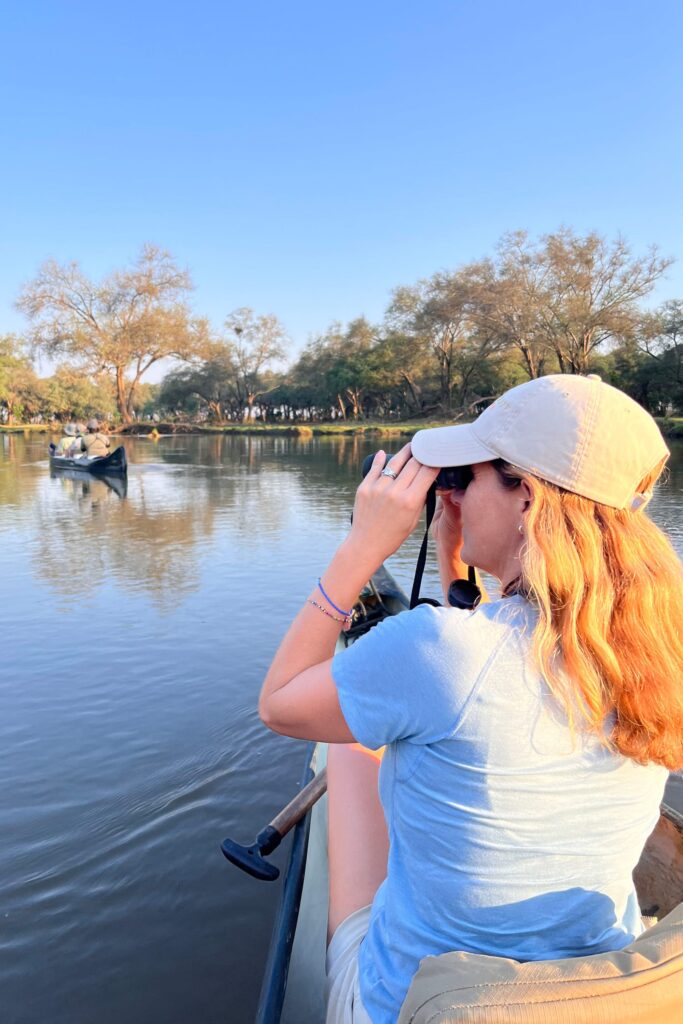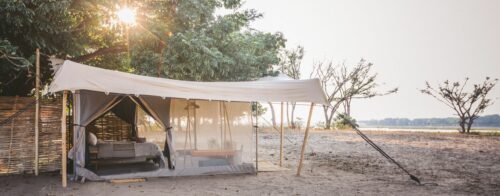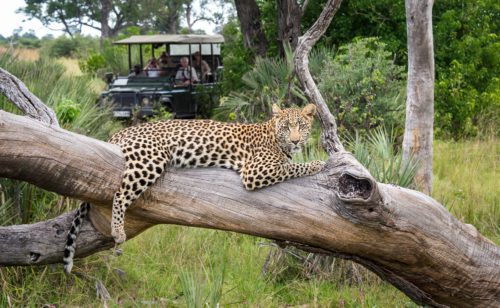Canoe along the Zambezi among hippo and crocodile, walk through the bush in search of big game with expert guides, and explore one of Africa’s most adventurous destinations on a trip to Zambia. Our Senior Safari Specialist, Lara, is just back with this wild itinerary.

Zambia is the kind of place where a curious elephant wakes you as it reaches through your bathroom window with its trunk; where a buffalo grazing happily stops you in your tracks on your way to dinner. A place where tracking wildlife on foot, through the bush, led by some of the best guides in the business, takes you just the right amount outside of your comfort zone.
It’s raw and real; an up close and personal safari experience. You are not just an observer here; you can become more immersed in the natural environment than in many other African safari destinations. To do that, there’s a great variety of experiences, with walking safaris, boating and canoeing, and classic game drives all on offer.
This itinerary was designed to channel that spirit, experiencing the extraordinary game of the two major national parks of South Luangwa and the Lower Zambezi, as well as Livingstone, where you can see the mighty Victoria Falls, and the lesser-visited Kafue for safari and to learn about local conservation efforts.
Days One to Four: South Luangwa National Park
Open grassy plains, untouched woodland, and the long meandering Luangwa River combine to create one of Southern Africa’s most diverse and exciting national parks. The game is exceptional, and the varied landscape brings species of all kinds, with a healthy population of rare wild dog, plenty of elephant, one of the biggest concentrations of hippo in Africa, and the elegant, endemic Thronicroft’s giraffe. It’s also a fantastic spot to catch a glimpse of the most elusive of the Big Five: the leopard. The variation and density of the game, and the many different ways of seeing it, means that you can stay in one place longer without exhausting experience options. Game drives are available night and day, but the real joy of South Luangwa National Park is getting out on foot.
Unlike other parts of Africa, the walking safaris of Zambia (British conservationist Norman Carr is said to have pioneered the practice in South Luangwa back in the 1950s and ‘60s) are much more than nature walks. You can spend hours in the bush, covering decent distances with your guide, as you track game. Being at ground level with the animals is a completely immersive, totally exhilarating experience—you tend to see less (most animals are terrified of humans and will stay away), but what you do see means more because you’ve had to work at it.
For a traditional tented safari stay, Lion Camp has everything you need for a relaxing, wildlife-focused few days. The ten rooms are comfortably furnished with either thatch or canvas roofs and no fences. Sungani is an elevated option on the edge of a shimmering lagoon. For birders, the hide at Sungani is a fantastic spot to see carmine bee-eaters, a beautiful bird with rich red and blue plumage.

Days five to seven: Kafue National Park
Kafue National Park offers the rare chance to visit a working conservation office and see the tremendous work being done to preserve Africa’s wilderness. One of the biggest problems facing Zambia is deforestation due to expanding farmlands and charcoal production. Visit the Musekese Conservation headquarters (one hour by motorboat from Musekese), where you’ll learn how rangers tackle the issue alongside other common problems, such as poaching.
This off-the-radar park also has exceptional game viewing, with large elephant herds, lions, and zebra present. You can combine all the activities that make Zambia such a special place to see wildlife—mix up your days with game drives, walking safaris, and, from selected locations, motorboat cruises and visits to the Musekese Conservation HQ.
Musekese Camp offers a down-to-earth tented experience with the right amount of amenities. This will suit you if you want a more relaxed, traditional safari experience. If you want something with more luxury, try Shumba Camp, a remote lodge at the heart of the sweeping Busanga Plains.

Days eight to ten: Lower Zambezi National Park
If South Luangwa is the place for walking safaris, the Lower Zambezi is its water equivalent. The mighty Zambezi River snakes through the park, with dense tree cover overhanging the water and forests of winter thorn trees and huge acacias inland. Small islets are formed by the many channels running off the river, where wildlife gathers in abundance.
It’s here you can take a canoe safari and get up close to the wildlife. Hippo and crocodile are everywhere. Massive herds of elephant gather at the water’s edge to drink. Leopard relax in the trees overlooking the river. Buffalo and waterbuck are often seen wading through the shallows between islands. Motor boats allow you to tackle the main channel of the Zambezi, where you can see lion on the banks and take in a spectacular sunset view at the end of the day.
To stay, Kutali Camp has the charm of a bush camp with added luxury and comforts. Sausage Tree Camp offers luxury overlooking a series of calm channels and islets, and the rooms have all the amenities you need.

Days 1o and 11: Livingstone
Most people stay in Livingstone for Victoria Falls, which really is a must if you haven’t seen it before. Its scale and power are truly awesome, even if the area is a little touristy.
A hair-raising dip in Devil’s Pool, a swimming hole on the lip of the falls, isn’t for everyone. Still, if you’re looking for adventure, the views combined with the rush of a swim at the edge of one of the most powerful waterfalls in Africa make for an unforgettable moment. Once you’ve seen the falls, visit the rhinos at Mosi-Oa-Tunya National Park on a walking safari. This might be your only chance to see rhino in Zambia as they’re very rare—they were poached almost to extinction here in the 1980s and ’90s.
For accommodation, it’s always better to avoid staying near the falls and choose a spot along the river, where things are calmer. Chundukwa will suit if you’re looking for a local vibe, as it’s owner-hosted. The property overlooks a lovely spot on the river, and there are many great activities, such as horse riding and mountain biking. For an elevated option with a polished feel, try Thorntree River Lodge.

Some of our favorite luxury Zambia itineraries

- Itinerary
Back to Nature Wilderness Adventure
Old-School Zambian adventure in owner-run camps

- Itinerary
Exploring Zambia: Walking and Waterways
Explore two of Zambia’s Iconic Parks and Diverse Activities
Plan your Trip
Ready to start planning your own incredible adventure? We make the process stress-free and enjoyable.
